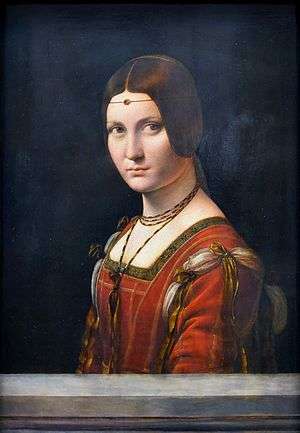La Belle Ferronnière
La Belle Ferronnière is a portrait of a lady, usually attributed to Leonardo da Vinci, in the Louvre, Paris. It is also known as Portrait of an Unknown Woman. The painting's title, applied as early as the seventeenth century, identifying the sitter as the wife or daughter of an ironmonger (a ferronnier), was said to be discreetly alluding to a reputed mistress of Francis I of France, married to a certain Le Ferron. Later she was identified as Lucretia Crivelli, a married lady-in-waiting to Duchess Beatrice of Milan, who became another of the Duke's mistresses.[1]
| La Belle Ferronnière | |
|---|---|
 | |
| Artist | Leonardo da Vinci or his Milanese circle |
| Year | 1490–1496 |
| Medium | Oil on wood |
| Dimensions | 62 cm × 44 cm (24 in × 17 in) |
| Location | Louvre, Paris |
Leonardo's Lady with an Ermine has also been known by this name. This was once believed to be a portrait of Cecilia Gallerani, one of the mistresses of Ludovico Sforza, Duke of Milan.[2] The narrative and the title were applied to Lady with an Ermine when it was in Princess Czartoryski's collection, and became confused with La Belle Ferronniere by the presence in this image also of a jewel worn on a delicate chain across the forehead, called a ferronnière.
This painting was on loan in Louvre Abu Dhabi, UAE[3] in 2017[4].
Attribution
Although the model of the painting La Belle Ferronniere is still shrouded in mystery, the landmark exhibition "Leonardo Da Vinci: Painter at the Court of Milan" (National Gallery, London, 9 Nov. 2011 – 5 Feb. 2012) listed the portrait as possibly depicting Beatrice d'Este, wife of Ludovico Sforza.[5] This challenges an earlier identification of the sitter as Lucrezia Crivelli, a mistress of Ludovico.[6]
Bernard Berenson attributed this portrait to Bernardino de' Conti.[7] Giovanni Antonio Boltraffio was suggested by Herbert Cook, who retracted his opinion, seeing Leonardo's own hand, in 1904.[8]
Copies
A later version of the painting, on canvas,[9] had been offered to the Kansas City Art Institute as the original, but was identified as a copy, on the basis of a photograph, by Sir Joseph Duveen, who permitted his remarks to be published in the New York World in 1920; the owner, Mrs Andrée Lardoux Hahn, sued for defamation of property in a notorious court case,[10] which involved many of the major connoisseurs of the day,[11] inspecting the two paintings side by side at the Louvre; the case was eventually heard in New York before a jury selected for not knowing anything of Leonardo or Morellian connoisseurship, and settled for $60,000 plus court expenses, which were considerable.[12][13] The owner's account, Harry Hahn's The Rape of La Belle (1946) is a classic of populist conspiracy theory applied to the art world. After decades in an Omaha vault, the Hahn La Belle was sold at auction by Sotheby's on January 28, 2010 as "by a follower of Leonardo, probably before 1750"; it brought 1.5 million dollars, a price three times higher than Sotheby's pre-sale estimate. The buyer was an unidentified American collector.[14][15]
A 19th-century copy of La Belle Ferronnière is conserved in the Musée des beaux-arts, Chambéry.[16] The Louvre painting is identified in pre-Revolutionary inventories of the French royal collection.[17]
Notes
- Dianne Hales: Mona Lisa
- Luke Syson and Larry Keith, Leonado Da Vinci: Painter at the Court of Milan, Exhibition Catalogue (National Gallery, London, 2011)
- "Louvre Abu Dhabi to be first museum in Middle East to show a Leonardo Da Vinci painting". The National. Retrieved 2020-07-03.
- Binlot, Ann. "Could This Leonardo Da Vinci Be The Louvre Abu Dhabi's Mona Lisa?". Forbes. Retrieved 2020-07-03.
- Luke Syson and Larry Keith, Leonado Da Vinci: Painter at the Court of Milan, Exhibition Catalogue, National Gallery (London, 2011)
- "Controversial painting 'La Belle Ferronniere', once thought to be a da Vinci, sells for $1.5M" . New York Daily News. Reuters. January 29, 2010.
- Berenson, Italian Pictures of the Renaissance: Central Italian and North Italian Schools (1968:48).
- Herbert Cook, "Some Notes on the Early Milanese Painters Butinone and Zenale. Part III (Conclusion) – Zenale as a Portrait Painter" The Burlington Magazine for Connoisseurs 5 No. 14 (May 1904:199-2090 p. 201f.
- Its earliest secure appearance was its purchase in 1847 by Antoine Vincent, from the collection of the comte de Betz, as from General Louis Tourton. (Brewer).
- "The most sensational art trial of the early twentieth century", according to John Brewer, "Art and Science: A Da Vinci Detective Story", Engineering and Science, No. 1/2 (2005); Brewer's The American Leonardo: A Tale of Obsession, Art and Money (New York: Oxford UP, 2009) is the definitive account of the Hahns' unsuccessful marketing of their painting.
- Bernard Berenson, Roger Fry, and the directors of the National Gallery, the Rijksmuseum, and others (Brewer).
- "Duveen on Da Vinci". Time.com. 1929-02-18. Retrieved 2013-07-22. (subscription required for full view)
- NYT staff (November 5, 1921). "$500,000 Suit Hangs on da Vinci Fingers: Impressions on Canvas Said to Prove Master Painted Picture Denounced by Duveen" (PDF). The New York Times. Retrieved 2014-02-08.
- "Mona Lisa She Is Not, but Coveted Nonetheless"
- ""La belle Ferronière d'après Léonard de Vinci"". Culture.gouv.fr. Retrieved 2013-07-17.
- Portrait de femme, dit La Belle Ferronnière, inv. 778